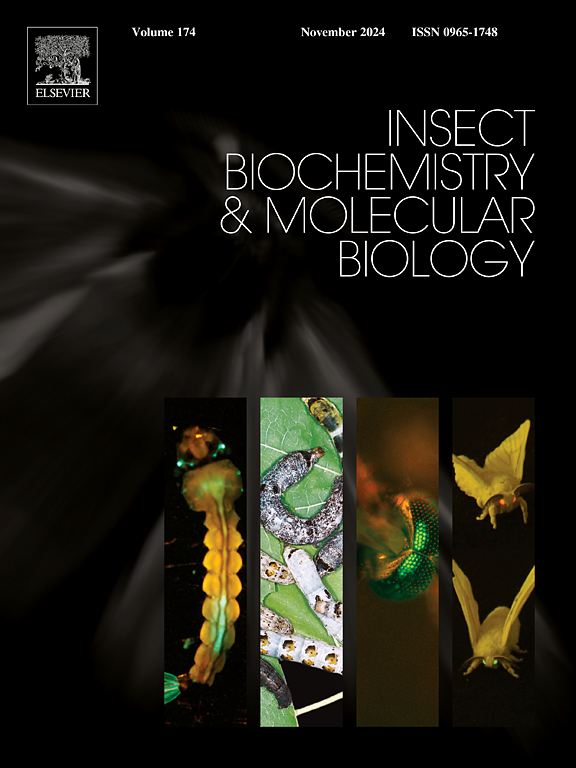Reciprocal roles of two trehalose transporters in aestivating cabbage stem flea beetle (Psylliodes chrysocephala)
IF 3.7
2区 农林科学
Q2 BIOCHEMISTRY & MOLECULAR BIOLOGY
引用次数: 0
Abstract
The cabbage stem flea beetle (Psylliodes chrysocephala, CSFB) is a significant pest of winter oilseed rape crops in northern Europe. CSFB adults aestivate during the summer to protect themselves from heat and desiccation stress. Trehalose, the primary hemolymph sugar, has been linked to energy homeostasis and stress resilience, but its regulation and function during aestivation remain poorly understood. Here, we investigated the roles of two trehalose transporters, Tret-1 and Tret-2, in modulating trehalose dynamics across different adult stages in CSFB. Through spatiotemporal transcript profiling, we found that Tret-1 was predominantly expressed in the fat body, where it facilitates trehalose export to the hemolymph, whereas Tret-2 expression was higher in the Malpighian tubules, mediating trehalose uptake from the hemolymph. RNA interference experiments revealed that Tret-1 is involved in transporting trehalose from the fat body into the hemolymph, while Tret-2 works reciprocally to transport trehalose from the hemolymph into the Malpighian tubules. The disruption of trehalose transportation resulted in excess glucose, glycogen, and triglyceride levels, mainly in pre-aestivation beetles. Furthermore, the knockdown of either trehalose transporter caused a compensatory increase in feeding activity in pre-aestivation beetles, while the knockdown of Tret-2 compromised resilience to heat stress. Our findings uncover the reciprocal functions of Tret-1 and Tret-2 in regulating trehalose distribution and maintaining metabolic stability during aestivation, offering insights into the physiological strategies underpinning insect survival during aestivation.

两种海藻糖转运体在白菜茎蚤甲虫(cylliodes chrysocephala)的鉴定中的相互作用
白菜茎虱(Psylliodes chrysocephala, CSFB)是北欧冬季油菜作物的重要害虫。CSFB成人在夏季休息,以保护自己免受炎热和干燥的压力。海藻糖是一种主要的血淋巴糖,与能量稳态和应激恢复能力有关,但其在呼吸过程中的调节和功能仍然知之甚少。在这里,我们研究了两种海藻糖转运蛋白Tret-1和Tret-2在调节CSFB不同成虫阶段海藻糖动态中的作用。通过时空转录分析,我们发现Tret-1主要在脂肪体中表达,它促进海藻糖向血淋巴的输出,而Tret-2在马尔比氏小管中表达更高,介导海藻糖从血淋巴的摄取。RNA干扰实验显示Tret-1参与将海藻糖从脂肪体转运到血淋巴,而Tret-2则参与将海藻糖从血淋巴转运到马氏小管。海藻糖运输的中断导致过量的葡萄糖、糖原和甘油三酯水平,主要发生在冬眠前的甲虫身上。此外,这两种海藻糖转运蛋白的敲低导致了冬眠前甲虫摄食活性的代偿性增加,而Tret-2的敲低则损害了对热应激的恢复能力。我们的研究结果揭示了Tret-1和Tret-2在调节海藻糖分布和维持冬眠期间代谢稳定中的相互作用,为昆虫在冬眠期间生存的生理策略提供了见解。
本文章由计算机程序翻译,如有差异,请以英文原文为准。
求助全文
约1分钟内获得全文
求助全文
来源期刊
CiteScore
7.40
自引率
5.30%
发文量
105
审稿时长
40 days
期刊介绍:
This international journal publishes original contributions and mini-reviews in the fields of insect biochemistry and insect molecular biology. Main areas of interest are neurochemistry, hormone and pheromone biochemistry, enzymes and metabolism, hormone action and gene regulation, gene characterization and structure, pharmacology, immunology and cell and tissue culture. Papers on the biochemistry and molecular biology of other groups of arthropods are published if of general interest to the readership. Technique papers will be considered for publication if they significantly advance the field of insect biochemistry and molecular biology in the opinion of the Editors and Editorial Board.

 求助内容:
求助内容: 应助结果提醒方式:
应助结果提醒方式:


